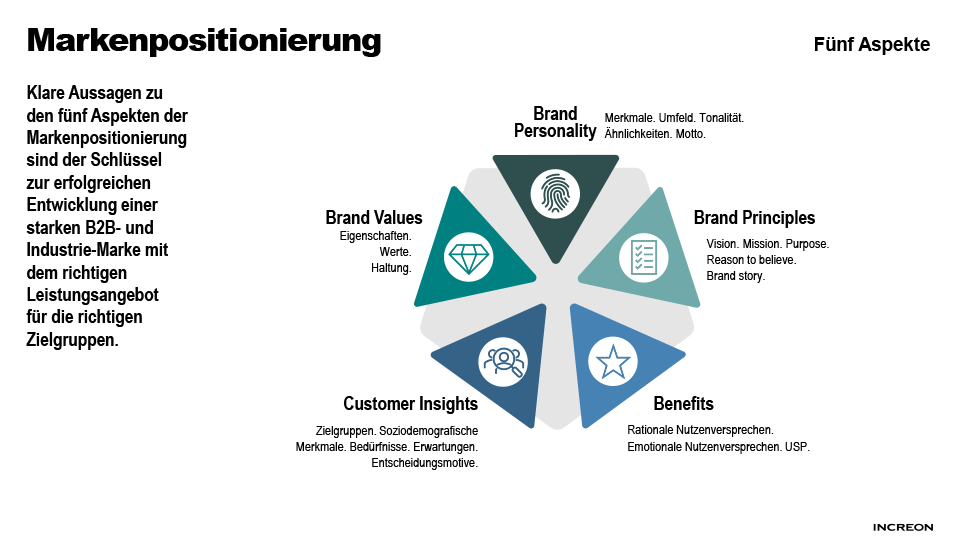Brand models
Over the decades, the number of brand models has grown. As a rule, they have become more complex because the role of the brand has also become more multifaceted. To this day, there is no right or wrong, no better or worse. Which brand model you work with depends on your situation.


BRAND MODELS.
Choose the right brand model or combine suitable models.
There is no one brand model. And not all brand models are the same. Sometimes the focus is on identity, sometimes on brand value, and sometimes on positioning. Sometimes it is more about the internal view, then again about the external view. It is important to decide on a suitable model depending on the situation and job to be done and to borrow from other models if aspects are missing.
Brand models at a glance
Brand models have evolved over the past few decades. They reflect the results of research and the spirit of the times. Different brand models also provide structure for different occasions. Brand models for a corporate brand in the international B2B environment or in a highly specialized niche market have to perform different functions than those for a strong product brand in the global B2C market. And there are different starting points: determining the identity, defining or further developing the positioning, influencing strategic corporate management, or being a helpful tool for marketing communication.
The following models provide a brief overview. With our “Five Principles,” we have developed an approach that has proven successful in many projects with B2B companies in industry and technology operating in specialized international markets.
Burmann’s identity-based brand model
Burmann’s identity model is strongly oriented to the characteristics of human identity. His model distinguishes between brand vision, brand personality, brand values, brand competence, brand origin, and brand performance. He contrasts performance with the expected brand benefit with the aim of achieving congruence between identity (self-image) and image (external image).
Brand Key
The brand key focuses on positioning. The competition, target groups, and customer insights are its foundation. Values, personality, and benefits are one level of analysis, the reason to believe and the differentiation of the buying impulse of the customer the other. This is how the brand essence is developed.
Aaker’s approach to identity
Aaker’s brand equity model explains brand equity as a mix of brand awareness, loyalty, and quality as perceived by customers. Aaker’s model assumes that these are assets that can help companies increase the commercial value of their products and services. The brand model can be used in different phases of marketing.
Golden Circle
With the Golden Circle, Simon Sinek describes a thought model and communication concept that focuses on three concise questions: Why, How, and What. Sinek thus addresses a central problem, because many companies and brands know what they do — but cannot say how and why. The question of why seeks to find the purpose, the intrinsic motivation that makes the brand what it is.
Esch brand steering wheel
The brand steering wheel consists of five components and is used for the systematic analysis of a brand. The analysis and description of brand benefits and brand attributes on the one hand, and brand tonality and brand image on the other, lead to the description of the brand core.
Bates Brand Wheel
The circle model works from the outside in, from the characteristics, benefits, and values via the personality to the essence of the brand. The aspects are analyzed and evaluated. At the center is the formulation of the brand essence, which states what the brand stands for. This, in turn, is the basis for strengthening the brand’s communication.
Kapferer identity prism
The brand identity prism is a concept from 1986 that illustrates how a brand expresses itself. Analyzed and further developed with the findings are six fields: Appearance and personality, culture and relationship with customers and the environment, self-image, and reflection in external perception. The purpose is for brands to recognize the relevant parts of their identity and work with them so that the brand can tell a story.
Brand Elements: Five aspects for B2B brand development
In our more than 20 years of branding work, we have further developed our brand evaluation method based on practical experience. To develop a holistic brand position for your B2B brand, our brand consulting services at our agency combine brand principles, brand personality, brand values, and brand benefits. Customer insights are the constant feedback to the market, decision makers, users, and employees.
Let’s discuss how we can develop your brand using our proven B2B model.






